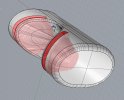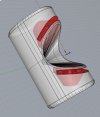I want to design a center channel that is similar to a Line Array box. I want it to be just a single box, and without the line array horn.
I am interested in learning more about uncommon speakers with driver arrangements, and I want to avoid issues "MTM" style center channel speakers have with horizontal directivity. I also just want to build something unusual, with the caveat that it works well, possibly better than the generic options. My goal is to roughly match the horizontal directivity of my main speakers, which are based on 12" B&C 12FHX76 coaxials. (HF is a 60x40 degree horn, crossed at 1,200hz)
The reason I'm not going straight to using another 12" coaxial for the center channel is because it would make a really tall center!
I have made some sketches of the ideas I have come up with. I think they all have problems, but it is a place to start.
The drivers I'm using in these examples:
Beyma 5CX200FE coaxial
FaitalPRO 6FE100 (2x)
FaitalPRO LTH102 60x50 degree horn
(CD to be determined)
Requirements:
Flat frequency response down to 100hz,
Capable of 110dB+ SPL @1 meter (To achieve THX reference level of 85dB + 20dB headroom at listening position)
![2024-05-08 19_34_16-Center Channel Design.3dm (2 MB) - Rhino 7 Commercial - [Top].jpg 2024-05-08 19_34_16-Center Channel Design.3dm (2 MB) - Rhino 7 Commercial - [Top].jpg](https://www.audiosciencereview.com/forum/index.php?attachments/2024-05-08-19_34_16-center-channel-design-3dm-2-mb-rhino-7-commercial-top-jpg.368504/)
0: This is the base line. It is the boring design that is a little better than a plain MTM. The 5" coaxial driver moves the crossover down to around 500hz or below, so I don't get beaming from the woofers.
1: This design is my first impression of a line array box, but it also uses a coaxial driver instead of a horn. This configuration narrows the distance between the 2 woofers, so the horizontal directivity from them should be similar to the 12" B&C.
One major issue it presents is that I can't install the woofers! So I have to make a separate box for the coaxial, and it needs to be removable..to allow installation of the drivers.
2: I've seen a few photos of line array boxes that look a bit like this. But of course they are using a special horn designed for the purpose. As drawn, I'd get the ~70 degrees horizontal directivity the coaxial is rated at, but the high frequencies in the vertical axis are bouncing off the inside of the box, which can't be good. Or does that matter? I don't know!
3: This is sort of a cross between a line array box and a Genelec "The Ones" monitor. I feel like it would work, but I don't know if there would be problems with the horn being in the middle, exposed to the woofers? One theory is that the area between the two drivers is pressurized evenly, so sound is not bouncing around, so not reflecting off the horn, causing distortion, smearing, etc. The other theory is that the sound will bounce all around behind the horn, causing major sonic problems. I'm not sure which one is correct.
If sound reflecting around before it makes it's way past the horn is a problem, I can modify it to be more like design #1, where the output of both woofers is isolated on either side of the high frequency driver.
Any thoughts? What ideas are workable, and what needs to be thrown out?
I am interested in learning more about uncommon speakers with driver arrangements, and I want to avoid issues "MTM" style center channel speakers have with horizontal directivity. I also just want to build something unusual, with the caveat that it works well, possibly better than the generic options. My goal is to roughly match the horizontal directivity of my main speakers, which are based on 12" B&C 12FHX76 coaxials. (HF is a 60x40 degree horn, crossed at 1,200hz)
The reason I'm not going straight to using another 12" coaxial for the center channel is because it would make a really tall center!
I have made some sketches of the ideas I have come up with. I think they all have problems, but it is a place to start.
The drivers I'm using in these examples:
Beyma 5CX200FE coaxial
FaitalPRO 6FE100 (2x)
FaitalPRO LTH102 60x50 degree horn
(CD to be determined)
Requirements:
Flat frequency response down to 100hz,
Capable of 110dB+ SPL @1 meter (To achieve THX reference level of 85dB + 20dB headroom at listening position)
0: This is the base line. It is the boring design that is a little better than a plain MTM. The 5" coaxial driver moves the crossover down to around 500hz or below, so I don't get beaming from the woofers.
1: This design is my first impression of a line array box, but it also uses a coaxial driver instead of a horn. This configuration narrows the distance between the 2 woofers, so the horizontal directivity from them should be similar to the 12" B&C.
One major issue it presents is that I can't install the woofers! So I have to make a separate box for the coaxial, and it needs to be removable..to allow installation of the drivers.
2: I've seen a few photos of line array boxes that look a bit like this. But of course they are using a special horn designed for the purpose. As drawn, I'd get the ~70 degrees horizontal directivity the coaxial is rated at, but the high frequencies in the vertical axis are bouncing off the inside of the box, which can't be good. Or does that matter? I don't know!
3: This is sort of a cross between a line array box and a Genelec "The Ones" monitor. I feel like it would work, but I don't know if there would be problems with the horn being in the middle, exposed to the woofers? One theory is that the area between the two drivers is pressurized evenly, so sound is not bouncing around, so not reflecting off the horn, causing distortion, smearing, etc. The other theory is that the sound will bounce all around behind the horn, causing major sonic problems. I'm not sure which one is correct.
If sound reflecting around before it makes it's way past the horn is a problem, I can modify it to be more like design #1, where the output of both woofers is isolated on either side of the high frequency driver.
Any thoughts? What ideas are workable, and what needs to be thrown out?

![2024-05-25 14_36_19-2024-05-25 Center speaker concept.3dm (944 KB) - Rhino 7 Commercial - [Top].jpg 2024-05-25 14_36_19-2024-05-25 Center speaker concept.3dm (944 KB) - Rhino 7 Commercial - [Top].jpg](https://audiosciencereview.com/forum/data/attachments/371/371259-132428b9ffc7e3a548e12a59a98fecf6.jpg)
